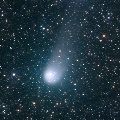
|
Now it is bright as 8.6 mag (July 4, Marco Goiato). It is observable at 7.5-8 mag for a long time from 2022 to 2023. In the Northern Hemisphere, it stays observable in good condition until autumn. However, it is not observable at the high light from autumn to 2023 summer. In the Southern Hemisphere, it stays observable in good condition for a long time.
Date(TT) R.A. (2000) Decl. Delta r Elong. m1 Best Time(A, h)
July 2 17 24.00 1 33.1 1.839 2.759 148 8.6 22:41 ( 0, 56)
July 9 17 9.34 -1 6.7 1.813 2.699 143 8.5 21:59 ( 0, 54)
|
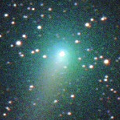
|
Now it is very bright as 9.8 mag (June 25, Marco Goiato). It will be fading gradually after this. In the Southen Hemisphere, it stays observable in good condition for a long time, although it becomes temporarily low in August. In the Northern Hemisphere, it is not observable until November when it fades down to 13 mag.
Date(TT) R.A. (2000) Decl. Delta r Elong. m1 Best Time(A, h)
July 2 8 52.02 -59 27.3 1.540 1.796 86 9.9 21:04 ( 38,-36)
July 9 9 6.91 -54 40.5 1.667 1.811 80 10.1 21:01 ( 44,-37)
|
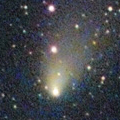
|
Now it is bright as 10.9 mag (July 4, Ken-ichi Kadota). In the Northern Hemisphere, it will be too low to observe soon. Then it will never be obsesrvable again. In the Souther Hemisphere, it is not observable until October when it fades down to 12 mag.
Date(TT) R.A. (2000) Decl. Delta r Elong. m1 Best Time(A, h)
July 2 8 38.45 36 40.6 1.967 1.176 28 10.1 21:04 (128, 9)
July 9 9 1.28 31 26.3 1.959 1.136 25 9.9 21:01 (124, 5)
|

|
Now it is 10.3 mag (June 21, Thomas Lehmann). In the Northern Hemisphere, it is already unobservable. In the Southern Hemisphere, it becomes unobservable temporarily from July to August.
Date(TT) R.A. (2000) Decl. Delta r Elong. m1 Best Time(A, h)
July 2 8 4.77 4 45.3 4.765 3.886 26 11.2 21:04 (109,-17)
July 9 8 12.16 3 43.3 4.820 3.912 23 11.3 21:01 (111,-21)
|
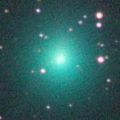
|
Now it is very bright as 11.3 mag (July 5, Thomas Lehmann). It will be fading after this. In the Southern Hemisphere, it stays observable in good condition for a long time. In the Northern Hemisphere, it will never be observable again.
Date(TT) R.A. (2000) Decl. Delta r Elong. m1 Best Time(A, h)
July 2 3 41.71 -19 55.9 1.943 1.712 61 11.8 3:04 (286,-11)
July 9 3 53.20 -24 35.5 1.925 1.796 67 12.3 3:08 (293,-10)
|
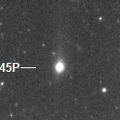
|
Now it is 11.2 mag (July 4, Ken-ichi Kadota). It is brighter than originally predicted by 3 mag. It brightened up to 6.7 mag in early May (May 10, Mike Olason). Now it is fading rapidly. The condition is very bad in this apparition. It is observable only in the extremely low sky from mid May to mid July in the Northern Hemisphere, or from early June to early August in the Southern Hemisphere.
Date(TT) R.A. (2000) Decl. Delta r Elong. m1 Best Time(A, h)
July 2 9 13.60 18 54.6 2.001 1.312 35 11.8 21:04 (109, 5)
July 9 9 37.91 17 6.2 2.115 1.405 34 12.4 21:01 (108, 4)
|
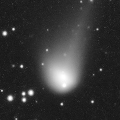
|
Now it is bright as 12.7 mag (July 2, Thomas Lehmann). It stays 12 mag for a while. It becomes unobservable from August to November in the Northern Hemisphere, or from September to December in the Southern Hemisphere.
Date(TT) R.A. (2000) Decl. Delta r Elong. m1 Best Time(A, h)
July 2 12 4.68 -5 2.4 4.244 4.247 83 11.9 21:04 ( 64, 25)
July 9 12 9.63 -4 30.9 4.351 4.250 77 12.0 21:01 ( 68, 21)
|

|
Now it is very bright as 12.8 mag (June 23, Thomas Lehmann). It will be unobservable soon.
Date(TT) R.A. (2000) Decl. Delta r Elong. m1 Best Time(A, h)
July 2 4 31.30 20 11.2 1.218 0.621 30 12.1 3:04 (247, 2)
July 9 5 18.59 20 2.5 1.310 0.603 26 12.0 3:08 (245, -1)
|
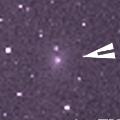
|
Now it is 11.7 mag (July 5, Thomas Lehmann). It stays observable in good condition after this. But it will be fading gradually after this.
Date(TT) R.A. (2000) Decl. Delta r Elong. m1 Best Time(A, h)
July 2 1 2.20 2 47.7 1.675 1.873 84 12.1 3:04 (293, 34)
July 9 1 11.77 3 23.9 1.642 1.910 88 12.3 3:08 (297, 38)
|

|
Now it is 13.6 mag (July 1, Thomas Lehmann). It will brighten up to 12.5 mag in summer. In the Southern Hemisphere, it stays observable in excellent condition for a long time. In the Northern Hemisphere, it is not observable until August.
Date(TT) R.A. (2000) Decl. Delta r Elong. m1 Best Time(A, h)
July 2 19 48.47 -64 8.7 2.224 3.052 137 12.6 1:13 ( 0, -9)
July 9 19 7.18 -62 57.9 2.190 3.036 139 12.5 0:05 ( 0, -8)
|
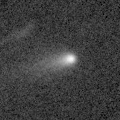
|
Now it is 12.8 mag (July 2, Thomas Lehmann). It is expected to brighten up to 11-12 mag from summer to autumn. It stays observable in good condition in the Southern Hemisphere. In the Northern Hemisphere, it becomes extremely low from August to September.
Date(TT) R.A. (2000) Decl. Delta r Elong. m1 Best Time(A, h)
July 2 11 1.69 13 45.6 1.337 1.237 61 13.5 21:04 ( 90, 23)
July 9 11 17.30 11 3.6 1.309 1.182 59 13.2 21:01 ( 89, 20)
|

|
Now it is 13.0 mag (July 4, Thomas Lehmann). It stays observable at 13-14 mag for a while.
Date(TT) R.A. (2000) Decl. Delta r Elong. m1 Best Time(A, h)
July 2 18 48.73 -31 40.3 2.031 3.040 171 13.2 0:11 ( 0, 23)
July 9 18 43.35 -31 59.1 2.036 3.040 168 13.2 23:34 ( 0, 23)
|
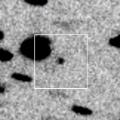
|
Now it is 14.2 mag (July 3, Thomas Lehmann). It stays 13-14 mag for a while. It is observable in excellent condition in the Southern Hemisphere. It locates somewhat low in the Northern Hemisphere.
Date(TT) R.A. (2000) Decl. Delta r Elong. m1 Best Time(A, h)
July 2 23 11.00 -21 34.8 1.206 1.912 118 13.3 3:04 (336, 30)
July 9 23 13.58 -22 20.7 1.184 1.949 124 13.4 3:08 (344, 31)
|
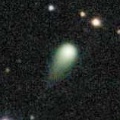
|
Now it is 13.3 mag (July 2, Thomas Lehmann). It is expected to brighten up to 10 mag in 2023. In the Northern Hemisphere, it stays observable in good condition until 2023 autumn. In the Southern Hemipshere, it stays unobservable until 2023 summer.
Date(TT) R.A. (2000) Decl. Delta r Elong. m1 Best Time(A, h)
July 2 9 52.83 55 21.4 4.635 4.018 47 13.4 21:04 (139, 29)
July 9 9 54.41 54 46.4 4.625 3.962 44 13.3 21:01 (140, 26)
|
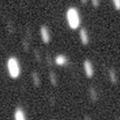
|
Now it is 13.5 mag (July 3, Michael Jager). It will approach to Earth down to 0.29 a.u. in 2023 February, and it is expected to brighten up to 5 mag. In the Northern Hemisphere, it stays observable in excellent condition. In the Southern Hemisphere, it becomes unobservable from late September to early February.
Date(TT) R.A. (2000) Decl. Delta r Elong. m1 Best Time(A, h)
July 2 18 58.87 31 59.3 2.279 2.979 124 13.5 0:21 ( 0, 87)
July 9 18 40.55 33 36.2 2.213 2.901 123 13.4 23:29 ( 0, 89)
|
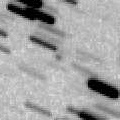
|
In the Southern Hemisphere, it is appearing in the morning sky. It stays observable in good condition after this. In the Northern Hemisphere, it is not observable at all.
Date(TT) R.A. (2000) Decl. Delta r Elong. m1 Best Time(A, h)
July 2 6 17.74 -50 13.0 1.151 1.301 73 13.4 3:04 (308,-50)
July 9 7 39.32 -53 31.6 1.142 1.335 76 13.5 21:01 ( 46,-49)
|
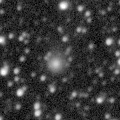
|
Now it is 13.6 mag (July 4, Thomas Lehmann). It is expected to brighten up to 11 mag in 2023. In the Northern Hemisphere, it stays observable in good condition until November. But it becomes unobservable after that. In the Southern Hemisphere, it stays observable in good condition for a long time, although it becomes unobservable temporarily from November to January.
Date(TT) R.A. (2000) Decl. Delta r Elong. m1 Best Time(A, h)
July 2 18 6.61 14 47.2 3.423 4.263 141 13.6 23:24 ( 0, 70)
July 9 17 58.64 13 26.9 3.390 4.219 139 13.5 22:49 ( 0, 68)
|
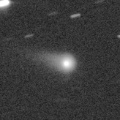
|
Now it is 13.8 mag (July 2, Michael Jager). It is expected to brighten up to 12 mag in 2023. In the Northern Hemisphere, it stays observable in good condition for a long time. In the Southern Hemisphere, it locates extremely low in 2022, but it will be observable in good condition in 2023.
Date(TT) R.A. (2000) Decl. Delta r Elong. m1 Best Time(A, h)
July 2 13 44.76 36 1.6 4.263 4.351 88 13.7 21:04 (101, 65)
July 9 13 38.89 34 24.7 4.325 4.318 82 13.7 21:01 (100, 59)
|
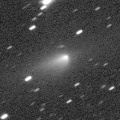
|
Now it is 13.9 mag (June 24, Chris Wyatt). It becomes too low to observe in mid August in the Northern Hemisphere, or in late September in the Southern Hemisphere.
Date(TT) R.A. (2000) Decl. Delta r Elong. m1 Best Time(A, h)
July 2 11 3.35 6 47.2 2.436 2.200 64 14.0 21:04 ( 84, 20)
July 9 11 15.15 5 23.2 2.501 2.198 61 14.0 21:01 ( 85, 16)
|

|
Now it is not observable. It will be observable again in August.
Date(TT) R.A. (2000) Decl. Delta r Elong. m1 Best Time(A, h)
July 2 5 51.84 29 14.8 6.987 6.000 12 14.1 3:04 (228, -6)
July 9 5 58.00 29 14.2 6.962 6.002 17 14.1 3:08 (232, -2)
|
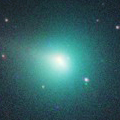
|
It brightened up to 8.8 mag from winter to early spring (Jan. 31, Chris Wyatt). Now it is fading. It has already faded down to 13.0 mag (July 2, Thomas Lehmann). It locates extremely low in the Southern Hemisphere. It will be unobservable in August in the Northern Hemisphere.
Date(TT) R.A. (2000) Decl. Delta r Elong. m1 Best Time(A, h)
July 2 9 40.42 36 45.0 2.775 2.107 40 14.5 21:04 (122, 19)
July 9 9 58.19 35 20.8 2.862 2.160 38 14.7 21:01 (121, 17)
|

|
Now it is not observable. It will appear in the morning sky in September in the Northern Hemisphere, or in November in the Southern Hemisphere. It will brighten up to 11.5 mag in winter
Date(TT) R.A. (2000) Decl. Delta r Elong. m1 Best Time(A, h)
July 2 6 39.05 21 46.9 3.246 2.230 1 14.7 3:04 (225,-19)
July 9 6 54.65 21 33.8 3.202 2.189 3 14.5 3:08 (228,-16)
|
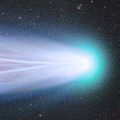
|
It brightened up to 3 mag from mid December to late December. Now it is fading. It has already faded down to 13.4 mag (May 28, Thomas Lehmann). It is observable in good condition in the Southern Hemisphere. It is getting observable again also in the Northern Hemisphere.
Date(TT) R.A. (2000) Decl. Delta r Elong. m1 Best Time(A, h)
July 2 16 40.74 -31 32.4 2.074 3.008 151 14.9 21:58 ( 0, 24)
July 9 16 27.55 -29 53.0 2.225 3.095 142 15.1 21:18 ( 0, 25)
|

|
Now it is 14.5 mag (June 19, ATLAS South Africa). It was expected to brighten up to 13 mag in spring. But actually, it is fainter than originally expected. In the Southern Hemisphere, it stays observable in good condition for a long time. In the Northern Hemisphere, it is not observable until autumn.
Date(TT) R.A. (2000) Decl. Delta r Elong. m1 Best Time(A, h)
July 2 6 39.76 -39 28.4 3.472 3.136 62 14.9 3:04 (291,-54)
July 9 6 41.99 -39 12.1 3.485 3.139 62 15.0 3:08 (292,-48)
|

|
Now it is 15.2 mag (June 28, S. L. Ferreira). It stays at 15-16 mag for a long time. In the Southern Hemisphere, it stays observable in excellent condition for a long time. In the Northern Hemiphere, it locates extremely low in spring.
Date(TT) R.A. (2000) Decl. Delta r Elong. m1 Best Time(A, h)
July 2 14 54.67 -50 33.0 4.632 5.323 128 15.1 21:04 ( 8, 4)
July 9 14 46.42 -50 16.8 4.732 5.342 122 15.2 21:01 ( 13, 3)
|
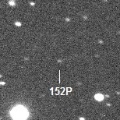
|
Now it is 16.7 mag (June 30, Ken-ichi Kadota). It will be fading gradually after this. It locates somewhat low in the Northern Hemisphere.
Date(TT) R.A. (2000) Decl. Delta r Elong. m1 Best Time(A, h)
July 2 19 47.43 -25 37.2 2.233 3.226 165 16.1 1:10 ( 0, 29)
July 9 19 42.85 -26 9.2 2.227 3.237 171 16.1 0:38 ( 0, 29)
|

|
It brightened up to 12.3 mag from spring to summer in 2021 (June 15, 2021, Marco Goiato). Now it is fading. It has already faded down to 15.5 mag (June 29, ATLAS-MLO, Mauna Loa).
Date(TT) R.A. (2000) Decl. Delta r Elong. m1 Best Time(A, h)
July 2 12 0.33 31 2.8 5.440 5.176 69 16.1 21:04 (102, 43)
July 9 11 59.89 30 45.4 5.586 5.220 63 16.3 21:01 (104, 38)
|
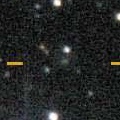
|
It is expected to brighten up to 12 mag from winter to summer in 2023. In the Northern Hemisphere, it stays observable in good condition until 2023 spring. It will be observable in good condition after August also in the Southern Hemisphere.
Date(TT) R.A. (2000) Decl. Delta r Elong. m1 Best Time(A, h)
July 2 4 10.15 39 23.9 4.715 3.939 36 16.3 3:04 (233, 17)
July 9 4 18.01 39 7.9 4.598 3.879 40 16.2 3:08 (236, 21)
|
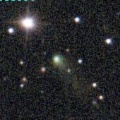
|
Now it is 16.1 mag (July 2, Thomas Lehmann). It stays observable at 16 mag from 2021 to 2022. It locates low in the Southern Hemisphere.
Date(TT) R.A. (2000) Decl. Delta r Elong. m1 Best Time(A, h)
July 2 15 27.63 43 12.6 4.899 5.173 99 16.3 21:04 (158, 81)
July 9 15 25.35 43 4.5 4.983 5.196 96 16.3 21:01 (136, 78)
|
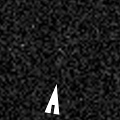
|
Now it is 16.9 mag (July 1, Ken-ichi Kadota). It is expected to brighten up to 15 mag in autumn, and it will be observable in good condition.
Date(TT) R.A. (2000) Decl. Delta r Elong. m1 Best Time(A, h)
July 2 0 36.59 3 51.6 2.058 2.294 89 16.4 3:04 (298, 39)
July 9 0 46.07 4 33.5 1.963 2.275 94 16.3 3:08 (302, 44)
|

|
It is expected to brighten very rapidly up to 11-12 mag in winter, and it will be observable in excellent condition.
Date(TT) R.A. (2000) Decl. Delta r Elong. m1 Best Time(A, h)
July 2 3 36.68 11 32.7 2.772 2.186 45 16.5 3:04 (261, 8)
July 9 3 51.60 12 9.7 2.691 2.157 48 16.4 3:08 (263, 12)
|

|
Now it is 16.3 mag (July 1, Ken-ichi Kadota). It brightened up to 14 mag from 2020 to 2021. Now it is fading slowly. It is observable at 16.5-17 mag in 2022.
Date(TT) R.A. (2000) Decl. Delta r Elong. m1 Best Time(A, h)
July 2 0 44.53 -13 46.8 3.521 3.748 94 16.5 3:04 (310, 25)
July 9 0 47.66 -13 58.4 3.442 3.766 100 16.5 3:08 (316, 29)
|

|
Now it is 16.9 mag (June 17, Giuseppe Pappa). It will brighten up to 16.5 mag in July. In 2022, it stays observable for a long time.
Date(TT) R.A. (2000) Decl. Delta r Elong. m1 Best Time(A, h)
July 2 23 40.43 2 27.5 0.456 1.206 103 16.7 3:04 (314, 48)
July 9 0 22.18 7 51.7 0.421 1.155 98 16.6 3:08 (306, 50)
|
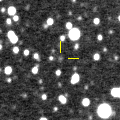
|
Now it is 16.8 mag (June 1, ATLAS South Africa). It will brighten up to 13 mag from 2024 to 2025.
Date(TT) R.A. (2000) Decl. Delta r Elong. m1 Best Time(A, h)
July 2 7 51.54 -23 54.6 8.328 7.712 49 16.6 21:04 ( 84,-36)
July 9 7 56.33 -23 57.9 8.324 7.676 47 16.6 21:01 ( 87,-40)
|

|
It brightened up to 14 mag in 2021. Now it is fading. It has already faded down to 16.5 mag (July 3, Thomas Lehmann). It is observable at 16-17 mag in 2022.
Date(TT) R.A. (2000) Decl. Delta r Elong. m1 Best Time(A, h)
July 2 0 13.39 10 29.7 5.589 5.725 92 16.6 3:04 (296, 48)
July 9 0 13.10 11 11.7 5.515 5.760 98 16.6 3:08 (304, 54)
|

|
It brightened up to 14.2 mag in 2021 summer (July 18, 2021, Taras Prystavski). Now it is fading. It has already faded down to 16.6 mag (June 11, ATLAS Chile). In the Southern Hemisphere, it stays observable in good condition for a long time. It locates somewhat low in the Northern Hemisphere.
Date(TT) R.A. (2000) Decl. Delta r Elong. m1 Best Time(A, h)
July 2 2 14.49 -25 3.0 4.937 4.879 80 16.8 3:04 (303, 2)
July 9 2 17.14 -25 0.4 4.890 4.919 85 16.8 3:08 (307, 7)
|
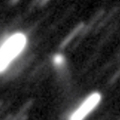
|
Now it is 16.6 mag (June 26, Ken-ichi Kadota). It was observed at 15 mag in 2021. Now it is fading. It stays observable at 16-17 mag for a while in 2022.
Date(TT) R.A. (2000) Decl. Delta r Elong. m1 Best Time(A, h)
July 2 18 11.38 29 37.2 4.742 5.413 126 16.8 23:29 ( 0, 85)
July 9 18 6.48 30 6.3 4.786 5.436 125 16.9 22:56 ( 0, 85)
|

|
Now it is 16.2 mag (June 30, Ken-ichi Kadota). It will be observable at 16.5 mag in good condition from summer to autumn.
Date(TT) R.A. (2000) Decl. Delta r Elong. m1 Best Time(A, h)
July 2 2 6.07 18 23.3 2.419 2.179 64 16.9 3:04 (268, 30)
July 9 2 18.14 19 35.3 2.364 2.193 67 16.9 3:08 (269, 35)
|
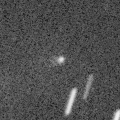
|
Now it is 16.9 mag (July 4, Ken-ichi Kadota). It is observable in excellent condition. But it will be fading rapidly, and it will be fainter than 18 mag in August.
Date(TT) R.A. (2000) Decl. Delta r Elong. m1 Best Time(A, h)
July 2 14 37.55 -2 59.0 0.699 1.476 117 16.9 21:04 ( 26, 48)
July 9 14 44.36 -7 51.7 0.726 1.473 114 17.0 21:01 ( 29, 42)
|
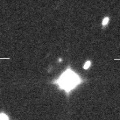
|
Now it is 17.1 mag (June 16, ATLAS-MLO, Mauna Loa). It is expected to brighten up to 12.5 mag in winter. It will become unobservable temporarily at 17 mag in July. In the Northern Hemisphere, it will become observable again in October. Then it stays observable in good condition after that. In the Southern Hemisphere, it is not observable at the high light.
Date(TT) R.A. (2000) Decl. Delta r Elong. m1 Best Time(A, h)
July 2 10 33.77 10 22.1 3.745 3.293 56 17.0 21:04 ( 92, 16)
July 9 10 37.12 11 3.4 3.782 3.229 50 17.0 21:01 ( 95, 12)
|
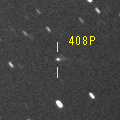
|
Appearing in the morning sky. It will be observable at 16 mag in excellent condition from autumn to winter.
Date(TT) R.A. (2000) Decl. Delta r Elong. m1 Best Time(A, h)
July 2 3 23.15 10 3.9 4.074 3.497 49 17.1 3:04 (264, 10)
July 9 3 31.63 10 7.8 3.994 3.493 53 17.1 3:08 (268, 15)
|
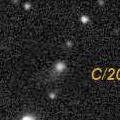
|
Now it is 17.0 mag (July 1, Ken-ichi Kadota). It stays observable at 17-18 mag for a long time until 2024.
Date(TT) R.A. (2000) Decl. Delta r Elong. m1 Best Time(A, h)
July 2 13 21.93 4 39.4 8.633 8.817 97 17.1 21:04 ( 56, 45)
July 9 13 20.21 4 43.5 8.755 8.817 90 17.1 21:01 ( 62, 40)
|
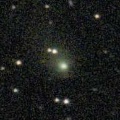
|
It became brighter after the perihelion passage, and it brightened up to 13.4 mag in early 2022 (Jan. 7, Hiroshi Abe). Now it is fading. It has already faded down to 16.1 mag (June 21, Thomas Lehmann). It will be fainter than 18 mag in summer.
Date(TT) R.A. (2000) Decl. Delta r Elong. m1 Best Time(A, h)
July 2 10 26.82 -2 11.8 4.680 4.265 60 17.1 21:04 ( 82, 7)
July 9 10 28.93 -3 3.7 4.821 4.310 54 17.2 21:01 ( 85, 2)
|

|
It approached to Sun down to 0.14 a.u. on May 15. But it was not observable around that time. Appearing in the morning sky. In the Northern Hemisphere, it stays observable at 17-18 mag in good condition from July to November. In the Southern Hemisphere, it stays extremely low.
Date(TT) R.A. (2000) Decl. Delta r Elong. m1 Best Time(A, h)
July 2 3 27.78 33 31.3 1.637 1.144 43 17.2 3:04 (243, 21)
July 9 3 37.25 34 44.2 1.668 1.245 48 17.4 3:08 (244, 26)
|

|
Now it is 17.4 mag (July 1, Ken-ichi Kadota). It is observable at 17 mag in good condition from July to August.
Date(TT) R.A. (2000) Decl. Delta r Elong. m1 Best Time(A, h)
July 2 20 45.00 -6 12.2 1.056 1.982 146 17.6 2:08 ( 0, 49)
July 9 20 4.46 -2 5.7 0.956 1.930 155 17.3 1:01 ( 0, 53)
|

|
Now it is 16.1 mag (July 1, Masayoshi Yoshimi). It will brighten up to 15 mag in autumn, and it will be observable in excellent condition.
Date(TT) R.A. (2000) Decl. Delta r Elong. m1 Best Time(A, h)
July 2 1 50.26 1 15.5 2.725 2.633 73 17.4 3:04 (286, 23)
July 9 1 58.96 2 28.8 2.623 2.610 78 17.3 3:08 (289, 29)
|

|
Now it is 16.9 mag (June 22, B. Koch). Fading slowly. In the Northern Hemisphere, it stays observable in good condition for a long time. In the Southern Hemisphere, it is not observable after this.
Date(TT) R.A. (2000) Decl. Delta r Elong. m1 Best Time(A, h)
July 2 18 18.33 68 22.6 9.218 9.247 88 17.3 23:34 (180, 57)
July 9 18 8.77 68 32.4 9.233 9.259 88 17.3 22:57 (180, 56)
|
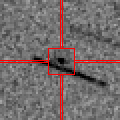
|
Now it is 17.8 mag (July 3, Michael Jager). It will brighten rapidly up to 15 mag in September, and it will be observable in good condition.
Date(TT) R.A. (2000) Decl. Delta r Elong. m1 Best Time(A, h)
July 2 23 41.10 24 57.2 1.284 1.682 93 17.6 3:04 (283, 63)
July 9 23 56.32 24 51.8 1.201 1.657 96 17.3 3:08 (288, 66)
|
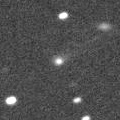
|
Now it is 17.4 mag (June 24, iTelescope Observatory, Siding Spring). It will be unobservable in September.
Date(TT) R.A. (2000) Decl. Delta r Elong. m1 Best Time(A, h)
July 2 13 10.95 -7 49.8 4.440 4.716 99 17.4 21:04 ( 48, 34)
July 9 13 13.10 -8 6.3 4.546 4.718 93 17.5 21:01 ( 53, 30)
|
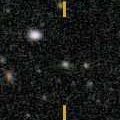
|
Now it is 17.8 mag (June 3, Toshihiko Ikemura, Hirohisa Sato). It is observable at 17 mag from spring to summer. In the Northern Hemisphere, it becomes low in summer.
Date(TT) R.A. (2000) Decl. Delta r Elong. m1 Best Time(A, h)
July 2 11 54.10 7 18.4 2.033 2.041 76 17.4 21:04 ( 76, 30)
July 9 12 3.18 4 50.6 2.096 2.034 72 17.4 21:01 ( 77, 26)
|
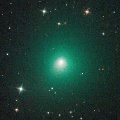
|
It brightened up to 9.5 mag in early summer in 2021 (June 27, Marco Goiato). Now it is fading. It has already faded down to 17.2 mag (July 3, ATLAS Chile). In the Northern Hemisphere, it stays extremely low.
Date(TT) R.A. (2000) Decl. Delta r Elong. m1 Best Time(A, h)
July 2 23 24.47 -35 37.9 3.798 4.377 118 17.5 3:04 (339, 16)
July 9 23 24.27 -36 29.2 3.784 4.436 124 17.6 3:08 (345, 17)
|
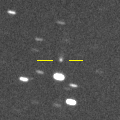
|
Now it is 17.6 mag (June 7, ATLAS Chile). It will brighten up to 16 mag in 2023. In the Southern Hemisphere, it stays observable in good condition for a long time. In the Northern Hemisphere, it will never be observable again.
Date(TT) R.A. (2000) Decl. Delta r Elong. m1 Best Time(A, h)
July 2 9 58.09 -19 3.4 4.208 3.866 63 17.5 21:04 ( 72, -8)
July 9 10 3.56 -19 44.5 4.245 3.831 59 17.5 21:01 ( 74,-12)
|
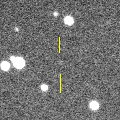
|
It is expected to brighten up to 7 mag in early 2024. In the Southern Hemisphere, it stays observable in good condition for a long time. It will appear in the morning sky in mid August also in the Northern Hemisphere, but it stays low in 2022.
Date(TT) R.A. (2000) Decl. Delta r Elong. m1 Best Time(A, h)
July 2 5 32.90 -18 40.5 7.372 6.693 45 17.6 3:04 (271,-33)
July 9 5 37.50 -18 55.6 7.281 6.634 47 17.5 3:08 (275,-27)
|
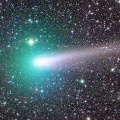
|
It brightened up to 8.5 mag from autumn to winter in 2021 (Dec. 2, Toshihiko Ikemura, Hirohisa Sato). Now it is fading. It has already faded down to 16.5 mag (May 26, Catalina Sky Survey). It will be unobservable soon.
Date(TT) R.A. (2000) Decl. Delta r Elong. m1 Best Time(A, h)
July 2 10 36.70 11 11.0 3.210 2.786 56 17.6 21:04 ( 92, 17)
July 9 10 45.86 10 10.0 3.336 2.836 52 17.8 21:01 ( 93, 13)
|
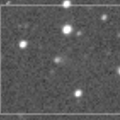
|
It was observed at 17 mag in 2021. It is observable at 17-18 mag also in 2022.
Date(TT) R.A. (2000) Decl. Delta r Elong. m1 Best Time(A, h)
July 2 2 33.87 3 38.0 3.651 3.316 63 17.6 3:04 (277, 16)
July 9 2 39.38 4 36.5 3.579 3.333 67 17.6 3:08 (280, 22)
|
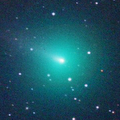
|
It brightened very rapidly up to 9.2 mag in winter (Jan. 31, Chris Wyatt). Now it is fading. It has already faded down to 16.8 mag (June 12, Catalina Sky Survey). It will be fainter than 18 mag in July.
Date(TT) R.A. (2000) Decl. Delta r Elong. m1 Best Time(A, h)
July 2 10 42.17 5 59.3 2.586 2.256 59 17.6 21:04 ( 86, 15)
July 9 10 54.42 4 56.4 2.712 2.313 56 18.0 21:01 ( 87, 12)
|
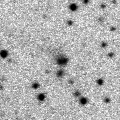
|
Now it is 17.2 mag (July 2, C. Gerhard). It started fading before the perihelion passage. It was predicted to stay at 16 mag for a long time. But actually, it will be fainter than 18 mag in autumn. In the Northern Hemisphere, it stays observable in good condition for a long time. In the Southern Hemisphere, it is not observable until 2023.
Date(TT) R.A. (2000) Decl. Delta r Elong. m1 Best Time(A, h)
July 2 20 28.61 84 14.4 3.987 3.800 72 17.7 1:50 (180, 41)
July 9 19 19.72 83 27.9 3.961 3.810 74 17.7 0:13 (180, 41)
|

|
It stays observable at 17-18 mag in 2022. It locates somewhat low in the Southern Hemisphere.
Date(TT) R.A. (2000) Decl. Delta r Elong. m1 Best Time(A, h)
July 2 2 55.24 28 41.1 5.972 5.391 51 17.8 3:04 (251, 25)
July 9 2 54.82 28 54.3 5.875 5.397 57 17.7 3:08 (255, 31)
|
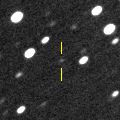
|
Now it is 17.8 mag (June 10, ATLAS Chile). It is expected to brighten up to 12-13 mag from 2024 to 2025.
Date(TT) R.A. (2000) Decl. Delta r Elong. m1 Best Time(A, h)
July 2 9 56.18 -19 11.9 7.962 7.561 63 17.8 21:04 ( 73, -9)
July 9 9 57.80 -18 47.0 8.008 7.517 57 17.8 21:01 ( 76,-13)
|
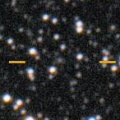
|
Now it is 17.1 mag (June 16, Mt. Lemmon Survey). It was observed at 17 mag in 2021. It is observable at 17-18 mag in 2022.
Date(TT) R.A. (2000) Decl. Delta r Elong. m1 Best Time(A, h)
July 2 23 27.13 0 2.0 3.760 4.177 107 17.9 3:04 (319, 47)
July 9 23 28.34 0 13.6 3.673 4.185 113 17.9 3:08 (330, 51)
|
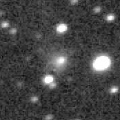
|
Now it is 17.2 mag (June 25, A. Diepvens). It was observed at 16 mag from 2020 to 2021. Now it is fading. It will be fainter than 18 mag in summer.
Date(TT) R.A. (2000) Decl. Delta r Elong. m1 Best Time(A, h)
July 2 22 16.77 14 6.6 6.338 6.842 115 17.9 3:04 (337, 68)
July 9 22 13.38 13 40.2 6.263 6.866 122 17.9 3:07 ( 0, 69)
|
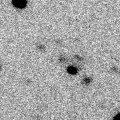
|
Now it is 17.5 mag (July 4, Michael Jager). In the Northern Hemisphere, it stays observable at 17 mag in good condition for a long time until winter. In the Southern Hemisphere, it stays extremely low for a long time.
Date(TT) R.A. (2000) Decl. Delta r Elong. m1 Best Time(A, h)
July 2 3 59.76 36 20.1 3.545 2.807 37 18.0 3:04 (237, 17)
July 9 4 14.88 37 28.1 3.489 2.797 40 17.9 3:08 (238, 20)
|
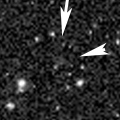
|
Now it is 17.3 mag (June 27, ATLAS South Africa). Very far object. It stays 18 mag for a long time from 2021 to 2026. In the Southern Hemisphere, it stays observable in good condition for a long time. In the Northern Hemisphere, it is not observable at all.
Date(TT) R.A. (2000) Decl. Delta r Elong. m1 Best Time(A, h)
July 2 7 43.82 -61 57.8 10.679 10.655 85 17.9 21:04 ( 35,-45)
July 9 7 47.17 -62 1.0 10.690 10.645 84 17.9 21:01 ( 34,-47)
|
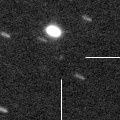
|
It is expected to brighten up to 8 mag in 2023 July. In 2022, it stays observable in good condition while the comet will be brightening gradually.
Date(TT) R.A. (2000) Decl. Delta r Elong. m1 Best Time(A, h)
July 2 3 27.72 8 25.2 5.472 4.864 48 18.1 3:04 (265, 8)
July 9 3 29.86 8 15.1 5.311 4.800 54 17.9 3:08 (269, 14)
|
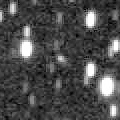
|
Now it is 17.9 mag (June 20, Catalina Sky Survey). It stayed 17.5 mag for a long time in 2021. It will be fading slowly after this. In the Northern Hemisphere, it is observable in good condition. It is not observable in the Southern Hemisphere.
Date(TT) R.A. (2000) Decl. Delta r Elong. m1 Best Time(A, h)
July 2 11 40.29 57 51.7 7.804 7.388 62 17.9 21:04 (139, 44)
July 9 11 43.41 56 43.0 7.872 7.406 59 18.0 21:01 (138, 41)
|
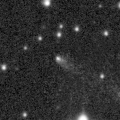
|
Now it is 18.5 mag (July 3, Michael Jager). It was expected to be observable at 16 mag in good condition in spring. But actually, it is fainter than predicted by 2-3 mag.
Date(TT) R.A. (2000) Decl. Delta r Elong. m1 Best Time(A, h)
July 2 21 16.14 7 41.9 0.908 1.755 131 18.7 2:38 ( 0, 63)
July 9 21 11.09 9 11.5 0.915 1.797 136 18.9 2:05 ( 0, 64)
|
|
![]()
 22P/Kopff
22P/Kopff C/2020 R7 ( ATLAS )
C/2020 R7 ( ATLAS ) 73P/Schwassmann-Wachmann 3
73P/Schwassmann-Wachmann 3 117P/Helin-Roman-Alu 1
117P/Helin-Roman-Alu 1 9P/Tempel 1
9P/Tempel 1 C/2020 V2 ( ZTF )
C/2020 V2 ( ZTF ) C/2022 E3 ( ZTF )
C/2022 E3 ( ZTF ) C/2021 T2 ( Fuls )
C/2021 T2 ( Fuls ) C/2020 K1 ( PanSTARRS )
C/2020 K1 ( PanSTARRS ) C/2019 U5 ( PanSTARRS )
C/2019 U5 ( PanSTARRS ) 116P/Wild 4
116P/Wild 4 29P/Schwassmann-Wachmann 1
29P/Schwassmann-Wachmann 1 19P/Borrelly
19P/Borrelly 81P/Wild 2
81P/Wild 2 C/2021 A1 ( Leonard )
C/2021 A1 ( Leonard ) C/2020 Y2 ( ATLAS )
C/2020 Y2 ( ATLAS ) C/2018 U1 ( Lemmon )
C/2018 U1 ( Lemmon ) 152P/Helin-Lawrence
152P/Helin-Lawrence C/2020 J1 ( SONEAR )
C/2020 J1 ( SONEAR ) C/2021 Y1 ( ATLAS )
C/2021 Y1 ( ATLAS ) C/2020 H6 ( ATLAS )
C/2020 H6 ( ATLAS ) 61P/Shajn-Schaldach
61P/Shajn-Schaldach 118P/Shoemaker-Levy 4
118P/Shoemaker-Levy 4 246P/NEAT
246P/NEAT 107P/(4015) Wilson-Harrington
107P/(4015) Wilson-Harrington C/2021 G2 ( ATLAS )
C/2021 G2 ( ATLAS ) C/2020 F5 ( MASTER )
C/2020 F5 ( MASTER ) C/2019 F1 ( ATLAS-Africano )
C/2019 F1 ( ATLAS-Africano ) C/2020 O2 ( Amaral )
C/2020 O2 ( Amaral ) 44P/Reinmuth 2
44P/Reinmuth 2 P/2022 C4 ( WISE-PanSTARRS )
P/2022 C4 ( WISE-PanSTARRS ) C/2022 A2 ( PanSTARRS )
C/2022 A2 ( PanSTARRS ) 408P/2020 M7 ( Novichonok-Gerke )
408P/2020 M7 ( Novichonok-Gerke ) C/2020 F2 ( ATLAS )
C/2020 F2 ( ATLAS ) C/2020 M5 ( ATLAS )
C/2020 M5 ( ATLAS ) (3200) Phaethon
(3200) Phaethon C/2022 L1 ( Catalina )
C/2022 L1 ( Catalina ) P/2022 L3 ( ATLAS )
P/2022 L3 ( ATLAS ) C/2019 O3 ( Palomar )
C/2019 O3 ( Palomar ) 327P/Van Ness
327P/Van Ness 99P/Kowal 1
99P/Kowal 1 100P/Hartley 1
100P/Hartley 1 C/2020 T2 ( Palomar )
C/2020 T2 ( Palomar ) C/2021 C5 ( PanSTARRS )
C/2021 C5 ( PanSTARRS ) C/2021 S3 ( PanSTARRS )
C/2021 S3 ( PanSTARRS ) 67P/Churyumov-Gerasimenko
67P/Churyumov-Gerasimenko 422P/2021 L1 ( Christensen )
422P/2021 L1 ( Christensen ) 104P/Kowal 2
104P/Kowal 2 C/2020 U5 ( PanSTARRS )
C/2020 U5 ( PanSTARRS ) C/2020 U4 ( PanSTARRS )
C/2020 U4 ( PanSTARRS ) C/2022 E2 ( ATLAS )
C/2022 E2 ( ATLAS ) 395P/2020 H1 ( Catalina-NEAT )
395P/2020 H1 ( Catalina-NEAT ) C/2019 T3 ( ATLAS )
C/2019 T3 ( ATLAS ) C/2021 QM45 ( PanSTARRS )
C/2021 QM45 ( PanSTARRS ) C/2019 E3 ( ATLAS )
C/2019 E3 ( ATLAS ) C/2021 T4 ( Lemmon )
C/2021 T4 ( Lemmon ) C/2020 P3 ( ATLAS )
C/2020 P3 ( ATLAS ) 325P/Yang-Gao
325P/Yang-Gao![]()


























































